Down the Heart of Death Valley
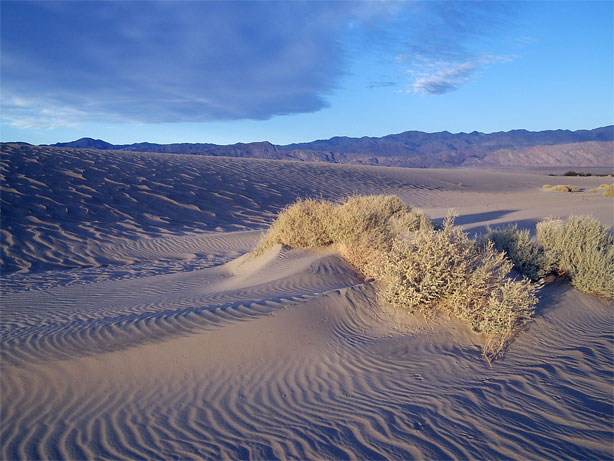
December 13, 2004
I had been in darkness for so long that the sun was almost unexpected this morning and startled me from my slumber at far too early of an hour. I was soft after a few months of living in Washington and was hoping that my time in Death Valley might help me return to that beautiful state of mind and being that I had enjoyed the previous three summers. That state where nothing catch touch you, where nothing can possibly affect you in any aspect of life that really matters, where you flow with life, rather than struggling against it. This is what I lose every fall as I "Re-Enter" the world of civil society, with the corresponding loss of freedom, openness, and love. A fall from Grace, or Eden. A fall that hurts when you realize that you've landed. I hoped for some relief with my time in the desert and it was with a flare of hope in my heart that I locked up my car, ate a final doughnut, shouldered my pack, and set out south down the valley floor.

My first couple of steps were up a small hill above the parking area to get a look at the valley south of me. On the third or fourth steps, I broke through some poor animal's den, torquing my right ankle, though not enough to hurt it. Unfortunately, it was enough to hurt the muscles behind my knee and the soreness set in rather rapidly, though I assumed it would simply disappear after a little while. From the top of the hill I could see north and south, east and west. Up valley and down, to the Grapevine mountains on my left and the Cottonwoods on my right. Mesquite Spring sits in a mini-canyon on the valley floor, carved by some long forgotten river, that perhaps still flows during a record rain year (six inches is the most precipitation that the valley has seen in recorded history) or if the winter snows in the Last Chance range are heavy enough.

The desert is a brown place, no doubt about it, although it takes only a few seconds to spot little bits of color, of non-conformity or free expression, in the sea of beige, tan, and grey. Little bits, thought, not large or gaudy expanses of color. A few bushes with microscopic leaves that still held some green. A shrub with slightly pale red berries. A paddle cactus sporting a drab green skin. A few pink rocks laying about. Not much else, except for myself: Green bandana, black jacket, black pants. A veritable riot of color. And, as out of place as a riot in the Sistine Chapel.

I was quickly acquainted with some of Death Valley's less agreeable dwellers, spikey, spiney, and ready to attack anything that might threaten their existence by getting a little too close. One I believed to be a Teddy Bear Cholla, and the other looked like a small version of a barrel cactus, although with a very thick armor of long, arced spines. One of the plants had tufts of what looked like cotton stuck to it. Perhaps some unlikely animal had gotten a wee bit too intimate with the plant.

Wandering down the valley, I made the mistake of leaving the dry river bed when it bent significantly to the east, choosing instead to head up along my own route. While this seemed to be a good choice initially, I quickly began running into ripples in the land. Some ripples developed into miniature canyons, though never more than fifteen feet high. Though not terribly tiring, neither was it good walking either and I quickly despaired of my initiative in leaving the wash. Still, there was a pleasant breeze and the outlandish texture of the dry, bare mountains rimming the valley gave me something to stare at other than the dry plants around me.

Finally the mini-canyons began to grow too large to continue scrambling up and down and I was forced to follow a large one all the way down to where it intersected with the wash I had originally been following and had left in a fit of efficiency. Trotting down the wash, my happiness at being out in the desert seemed ready to spill forth from my pores. Even the vague scent of the Valley in the winter time, without the floral power of a blooming desert, as I had been lucky enough to experience on the PCT in 2003, cheered me. There is so little here that any change in the scenery, or variation in scent, is noticed immediately. Maybe there was a single, flowering plant a few hundred yards from me. Perhaps it was a clutch of pine trees far up in the mountains whose scent I was receiving from the wind.

The wash eventually gained a wall to it and I was able to walk in the shade for a little while, wondering how it came to pass that the canyon had only a single wall. It wasn't as if there was anything more appropriate to ponder at the time and I amused myself with various, fantastical explanations for the odd landform. Most involved a giant boraxwasher, although some featured a robot or two.

My imagination needed a rest, as did my body, and so shortly after leaving the one walled canyon, though still in the wash, I found some shade cast by a large bush and settled in for some water and rest, the two most important things in the desert.

The afternoon floated by on the mellow breeze coming down the floor of the valley, drifting along almost without time. The rapidly arcing sun, racing for the Panamints, betrayed the passage of time in the Valley. By two o'clock the wash ran out and I found myself crossing perfectly flat scrub desert that slowly transitioned to sand, and then salt.

Mysterious formations began to appear around me on the salt flats, taking on a strange, sculpted rock nature. Upon closer inspection (meaning, I kicked a small one over), the formations appeared to be made out a salt-sand combination. How the salt had gotten twisted into such a strange artwork was beyond me, and I quickly felt bad about my "inspection" earlier. The sculptures were, perhaps, like coral, only formed by the wind and salt, rather than by water and living creatures and I should not have carelessly knocked one about.

The salt flats were firm enough to make walking comfortable, although if it had rained recently this place would have been an absolute disaster area. Even with the 70 degree airtemperature, the reflected light coming off the white surface was hot enough to make me sweat. In the summer I suspected that a person wearing shorts and a t-shirt would die within a hour or two.

By three o'clock I was off the salt flats and back onto dirt and gravel, with the sun nearing the Panamints. Once it got behind them, I would only have thirty minutes, perhaps an hour, of light before the cold of the desert night ushered in another long night in the sleeping bag, curled up with Dostoevsky and the stars.
I located an old roadbed, complete with a set of foot prints, running straight to Stovepipe Wells, which I could now make out as the sun was no longer shining directly into my eyes. The harsh light of midday had faded and it was now possible to see without wearing my sunglasses and to take pictures once again. The beautiful light that bathes the desert in the last hour of daytime made its ritual appearance and I started thinking about where to spend the night. It wouldn't be hard. Just a matter of deciding to stop and making sure that I wasn't camped on top of an anthill.

Tucki Mountain now hid the backside of Wildrose Peak and was absorbing the last of the rays of the now departed sun. Near its base sat Stovepipe, although I would not reach this watering hole until tomorrow morning, giving my disinclination to walk in the dark.

I took a final break for the day on the old road to look over the land during this most special of hours in the desert, when everything becomes perfect once again. Life returns, bringing with it beauty. As the road made a jog to the west, away from the straightline it had been following to Stovepipe, I left the road and started across the open desert once again, looking for an apppropriate place to camp for the night.

Although it was only 4:30, I stopped for the day and fired up the GPS to see that I had come 24 straightline miles from my car this morning. Setting up camp was as simple as it could be: Spread out the bivy sack over my sleeping pad, and put my sleeping bag over both of them. I quickly ate dinner, brie, dried salami, and fudge, in the remaining light and washed it down with plenty of water and a multivitamin and three ibuprofen tablets. My knee was still stiff from my misstep in the burrow, although I fully expected it to be better in the morning. The body heals quickly if you let it.
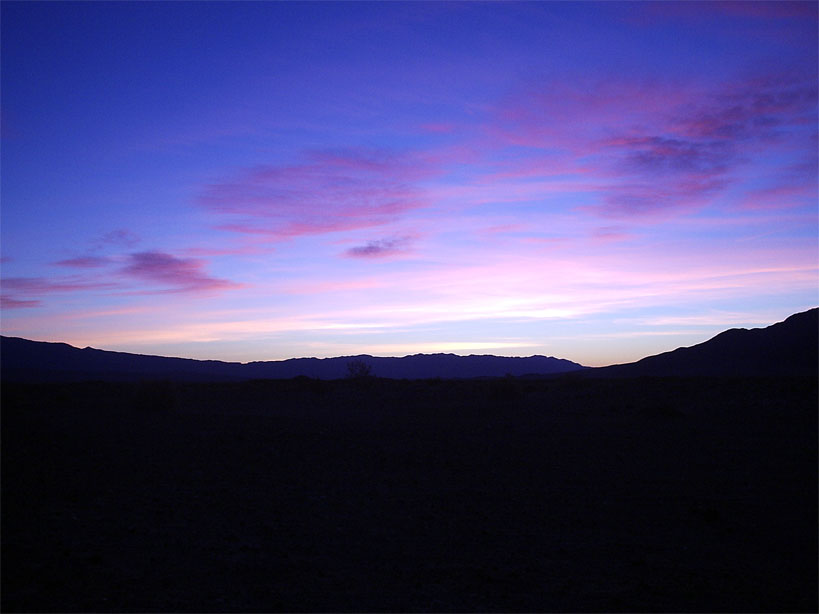
The light faded completely and the world went purple and blue and orange and pink and red and mauve and lavender and black, at last. The stars came out with the cold of the night and I got inside of my sleeping bag for the four hour reading and star watching session before I might be able to fall asleep. I was happy after the (relatively) short day of hiking and couldn't imagine anywhere that I might be happier. I made up some tea for a little companionship (caffeine can be a good friend in the aloneness of night) and drank it down while watching for satellites and shooting stars. Far to the southeast the mountains glowed red, most likely sourced from the vulgarity of Las Vegas. Despite its remoteness from this bastion of wilderness, I could think of no other source for the unnatural light. I thought about the little wonders that I had seen today. The odd, one-sided canyon in the wash. The chollas. The cactus with the cottony stuff on it. The salt coral. The serenity of sitting in the shade of a creosote bush. All these were here for anyone to have. There isn't a permit system in Death Valley. It costs nothing to camp overnight in the backcountry. There are few trails (about 15 miles in the entire park), but even fewer obstacles to exploring the valley on foot at this time of the year. All you have to do is carry enough water, pick a direction, and go.
There is a great feeling of aloneness out here, yet an aloneness that comes hand-in-hand with a sense of unity of purpose and direction. An odd combination, but in this barren land, with so little life, everything seems to be in equilibrium. Everything has its place and order reigns supreme. Each bit of life, each speck, is special and important, including myself, despite being a temporary desert dweller. In the Olympics, life abounds, gushes forth, is unrestrained, and the result is a sort of chaos and disunity, as life struggles with itself to fall into a stable state. Trees grow on other trees, moss grows on everything, bushes and shrubs battle each other and the trees for space, and wildlife plows through it all. It is a chaotic and enchanting place, and one that is as far from possible as Death Valley, where order and clarity dominate. Perhaps that is why I like the desert. Perhaps that is why I like the Olympics. I turned my headlamp and and opened Dostoevsky, satisfied with myself and myplace, and faced the long, cold night alone with only a long dead Russian to shelter me from the night.
The morning did not surprise me today and I was awake well before the sun had cleared the eastern mountains. The world was still purple as I set tea on to brew and munched down some muffin bars for breakfast. Stovepipe was only, perhaps, three miles from where I had slept and I did not expect it to be much work to get to it. The muscles behind my knee still ached and I took another three Ibuprofen tablets with my morning tea before packing and setting out for Stovepipe, the sun just barely behind the Armagosa. I looked far to the north from where I had come the day before, satisfied that I could no longer see any remnants of Mesquite Springs or Scotty's Castle.

The land was beginning to dry up, even for Death Valley and the gravel was quickly becoming cracked and broken up, creating wonderful textures to delight the latent artist in us all.
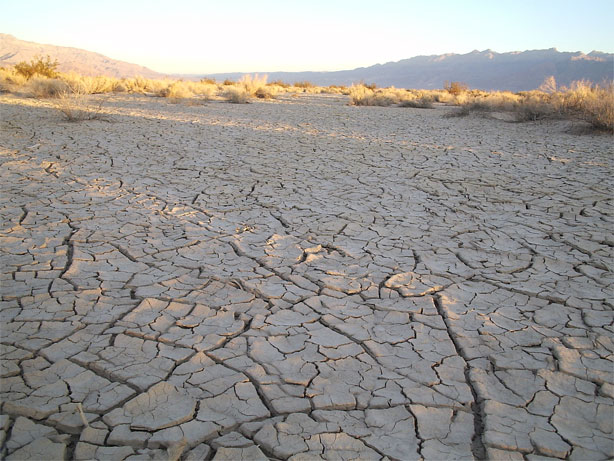
The parched land gave way to sand as I began the crossing of the low sand dunes directly north of Stovepipe Wells. There were much larger ones further to the east, but I had taken care not to veer too far in their direction. The low sun, now above the mountains, threw clever shadows upon the waves of sand as they began to build into ripples, and then ditches, and finally low dunes.
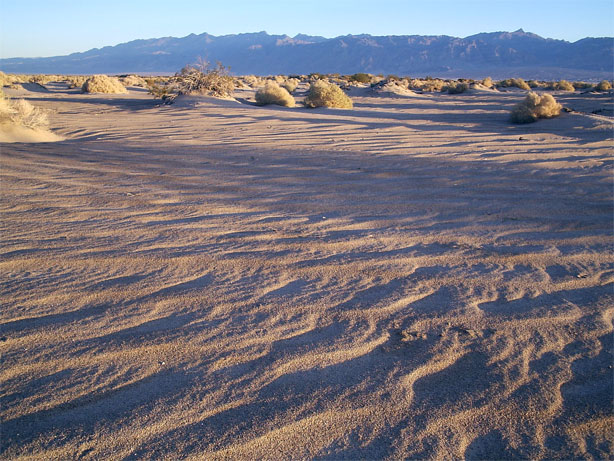
Despite the proximity to one of the main campgrounds in the park (perhaps less than a 30 minutes walk from here), it seemed no one came out here with any frequency. No footsteps, other than mine, marred the otherwise perfect, glassy surface of the sand dunes. Why not? It wasn't against regulations in the park (there were few of those to begin with) and one might think that after a day of driving around, a short walk out to this area from the RV might be a pleasant diversion. But, no. All I found were a few old, wind blown bits of trash. I picked them up from the canvas of the sand and marked along, going up and down the dunes.

The dunes threw me off my straightline course, and it was these that the old road must have been avoiding when it jogged to the west yesterday. I'd climb up to the top of one and then walk along the rim until I found a reasonable place to descend down the soft embankment of sand. While my shoes filled with sand, I didn't mind this too much, given how much fun I was having in the early morning light on the dunes.
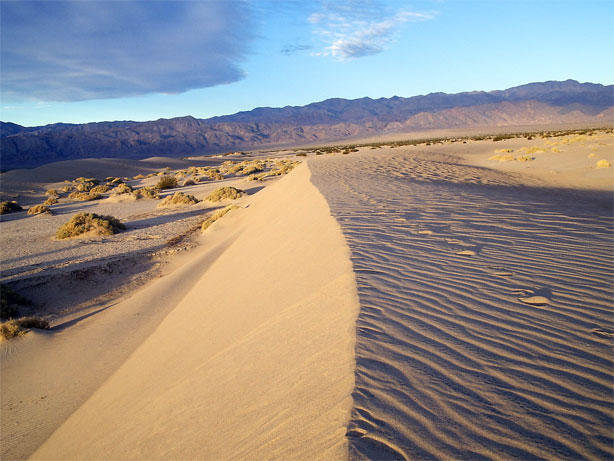
Alas, it was over too quickly and I found myself walking through the gravel RV park that formed Stovepipe Wells' campground. I dropped my pack on a table outside the store and went in for some extra calories that I would not have to carry on my back in order to enjoy. A few campers were out and and about, along with a beggar in the form of a coyote. I was tempted to throw a rock, but the campers and RVers seemed to be getting quite a bit of satisfaction out of the beggar and I thought it would be shameful for me to disrupt this. A crow came by to beg for part of the muffin I was eating, but left in a huff for the garbage bins when I finished and gave him the finger. I thought myself rather clever and had a quite chuckle, much to the bemusement of a woman sitting in the drivers seat of an SUV only a few feet away from my picnic table.
I loaded up all the water that I could carry, 14.4 liters, and shouldered the pack with a rather audible grunt. I had decided not to cross, and then recross, the Badwater Valley to get more water at Furnace Creek. Instead, I was carrying all the water I would need for the next three days, at the end of which I should be at my food and water cache near Warm Springs Canyon. Although making more work for myself, I did not want to have to rely upon finding the old corduroy running across the valley to Furnace Creek, nor did I want to be on the salt flats, even in the mild temperature. I set out east down HWY 190, which provided a smooth surface on which to walk for the few miles before I could cut south again, skirting the edge of Tucki mountain, and head down the Badwater valley. Walking a highway is never pleasant, except in the Canadian Rockies, though the early hour meant that there were few cars on the road and the hour passed without many problems from RVs or trailers.
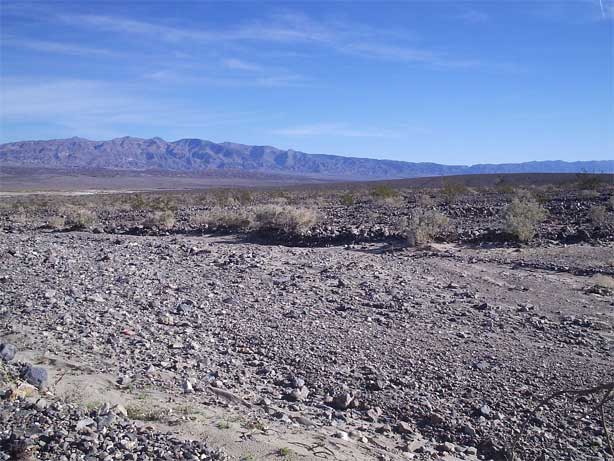
Near the Devil's Cornfeld I was able to break away from the road and start heading south again, cross country, hoping for the best from the footing. With no wash to follow, I was at the mercy of the alluvial fans coming off Tucki mountain. The numerous rocks (meaning they were everywhere underfoot) and the ripples in the land combined with the weight on my back to tire me quickly. When a pleasant creosote bush, with plenty of quality shade, appeared, I dropped underneath it to take a long rest and survey the land ahead. I closed my eyes and napped for ten minutes, then had some more to eat and drink, hoping to take some of the load off of my aching shoulders. I had in the neighborhood of 55 lbs on my back at this point, which is far, far more than the 20-25 lbs I normally carry when out backpacking. Perhaps this is why people didn't venture far from the frontcountry in Death Valley.
The terrain was just as hard on my feet and legs as before, and the pack just as heavy, particularly that now my jacket was riding on top of it, adding a little more weight to my burden. I amused myself by looking for interesting bits of life, and even found some. A pale, dusty blue/green plant happened to have a large collection of some sort of dried berries on it, and this gave me something to ponder for the next twenty minutes or so. Rather, to ponder until my shoulders began to hurt again. The ibuprofen from the morning was wearing off and the muscles behind my knee drummed out a slow beat of soreness.
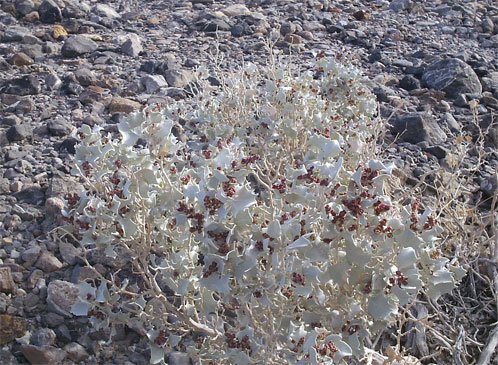
I crested a small hill and headed directly toward a row of powerlines running in the general direction that I was wanting to go. If powerlines were here, surely there would be some sort of road, or flattish area, that was also constructed when they were put in. Anything to get off the mile-after-mile rock strewn ground. The AT in Pennsylvania was cushy walking in comparison.
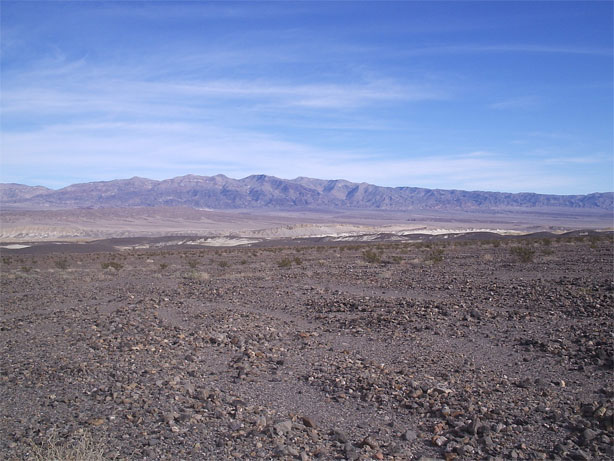
I reached the powerlines and began to follow them, finding not a road, but rather a track that was perhaps 25% less rocky than the open hillside I had been walking on. Clouds came in to shelter me from the sun and my mood began to improve, at least slightly. There were few bushes large enough to cast mansized shade, so the clouds gave me the perfect excuse to take a break, and a powerline pole became an excellent backrest. Needs are so few outside of civil society, that these two things, some shade from the clouds and something to lean against, seemed like great treasures. I grinned at how quickly the change was happening.
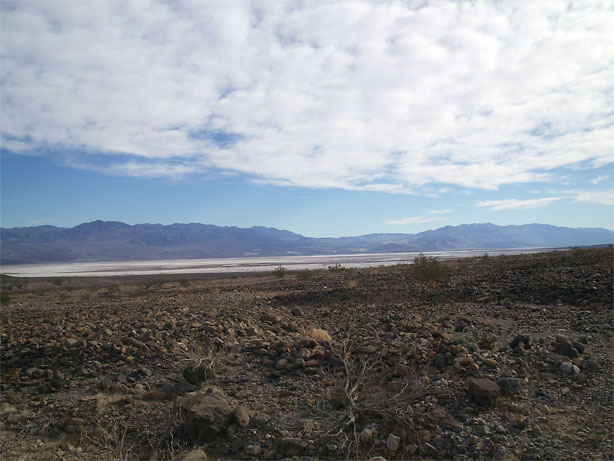
After a forty minute break, complete with short nap, I put the pig back onto my shoulders and set off, hoping to reach a salt spring before taking another break. The powerline track sometimes was obliterated by a flashflood channel, forcing me to move around and climb up and down out of such things, much to the delight of my aggravated knee. However, I stuck with the powerlines as they were consistently better than what I was faced with otherwise on the hillside.
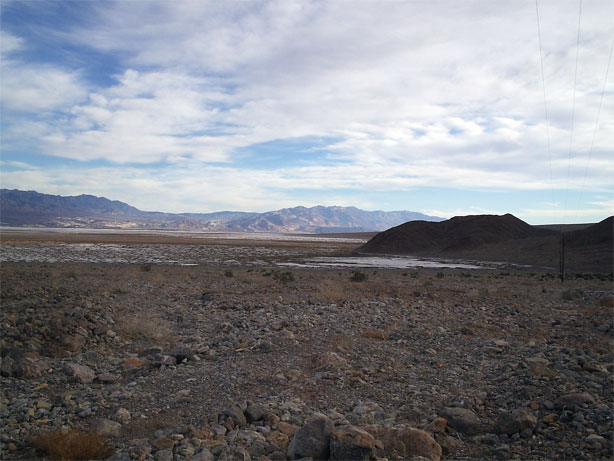
An hour of walking brought me to within sight of the spring area. The Badwater valley was a lake, and the spring area formed a cove in this lake, albeit one made of salt rather than of water. Something seemed out of place, however, in the cove. In the flat whiteness of the salt could be seen green things. And not drab olive like a cactus, but bright, happy, grass-like green. Green things in the salt? I had to know. I walked down to the edge of the cove and confirmed that there was indeed vegetation growing right in the middle of the salt cove. Where the spring was actually located was something of a mystery that I did not pursue, engaged as I was with the salty plants. I decided to call them pickle bushes, as the green growths (rather than leaves or needles) resembled mini deli pickles. Plus, pickles are found in a salty environment. Plus, there is some desert plant that grows in such places and is called a pickle bush. This was probably it, but even if it wasn't a pickle bush, it should be.
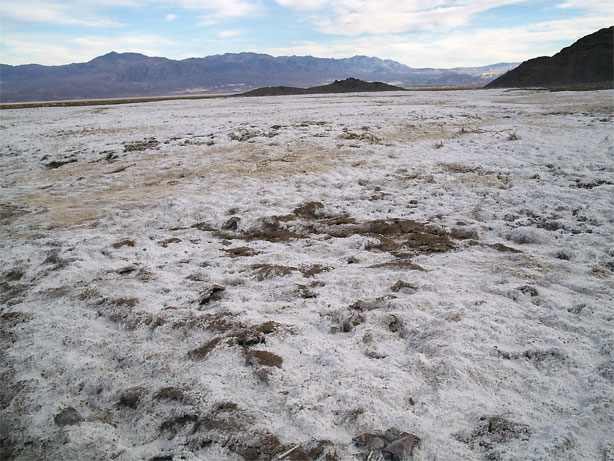
The powerlines ran up a hill that had slouched off from the mountainside and split a pass . I decided to deal with the salt as gently as I could and walk around the hill instead. The salt cove was decidedly delicate, with a structure more like shredded wheat than the clumps and sculptures of the day before. I stepped as delicately as I could, not because I was walking someplace where such activities were not allowed, but rather because it seemed a shame to leave tracks in such a unique environment.
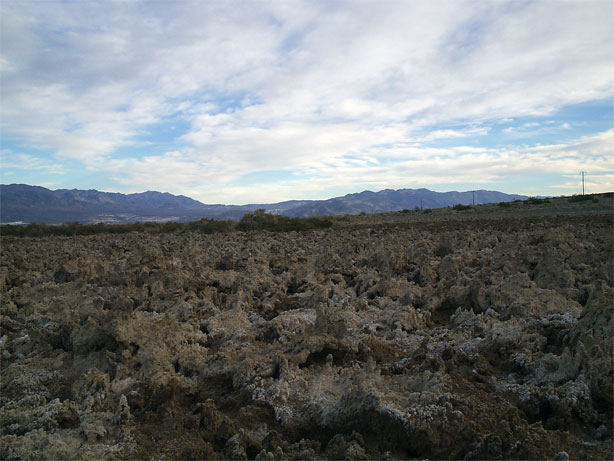
I followed small stream beds through the salt flats, dodging pickle bushes, until the land seemed to vomit up a mass of salt reefs, forcing me to plow straight across them, torquing and twisting my legs as the immaculate formations crumbled beneath my feet. I eventually reached the safety of something that looked like a road that ran around the hill, glad to be on solid ground once again and thrilled with the salt cove. Nobody, I assumed, ever came out here. It was much too far from a road or a trailhead for a day hiker and people did not seem to spend much time in the valley doing overnight trips in the backcountry. The salt cove was all mine, at least for a few more minutes before I rounded the hill and the wonderful little ecosystem vanished for good. When would the next person come through this area and find such a little treasure, sitting undisturbed, except for my tracks? Tomorrow for all I knew, but most likely it would be a while longer than that.

After rounding the hill I rejoined the poles for a while, before the shot away toward the valley, running, I assumed around the spit of land in front of me. I started climbing up the spit of land, despite the protest of the muscles behind my knee. The spit of land turned out to be rather more than I thought, and after gaining enough elevation I could see clearly that I was most definitely not heading in the right direction. I was sweating from the effort, my shoulders ached, and I had just wasted forty five minutes of my life to walk up here. Cursing, I began to follow various washes back toward the powerlines, but the light was waning and the mountains across the valley glowing purple, which meant that it was time for me to stop for the day. I found a small, flat bench above a minor wash and called it good.

Good? Better than good. A light breeze was blowing and I had views out to the Badwater valley in abundance. The quiet of the desert, relieved of the sound of my steps, provided my evening music as I ate my spartan dinner and heated water for tea. The temperature was dropping fast and I quickly got into my down jacket and warm hat, pulling the sleeping bag over my feet for a little extra warmth. I drank down the tea and watched the lights of Furnace Creek, almost directly across from me, flicker to life. Cars, in the form of their headlights, occasionally moved down Badwater road, and the glow from Las Vegas returned for a second night. The sense of aloneness in this place is magnificent, but I do not feel lonely. During the day I have the rocks to curse and the creosote to nap under. Picklebushes and salt flats and, today, the clouds keep me company. In the morning I have the incredible desert light at dawn to look forward to and in the evening the sunset to marvel at. When it gets black enough the stars overhead shine down on me; for me alone, I'd like to think. Everyday there is something is found of interest, be it the sand dunes of the morning or the salt cove and coral of the afternoon. What new thing tomorrow will wash into my life is unknown, for the moment. What is known is that something will come, something special and beautiful and unique and the lack of people out here means that it will be for my eyes or ears or mind alone. At least until the next fool comes wandering out into the Valley.
Bugs? Mosquitoes? I wanted to think that it was all a bad dream, but the bits of blood and bug legs on my face confirmed that my evening visitors were made of physical substance rather than mental brooding. I was below sea level, near one of the driest, hottest places on Earth. And yet I awoke with mosquito bites on my face. While not as ravenous as the bugs in places like the Canadian Rockies or the Oregon PCT, there were enough to disturb my sleep and make me wish for some DEET. DEET? I'm in Death Valley! How the hell could I ever have known that I should bring DEET to Badwater? Retched creatures.
I was up well before the sun had crested the Armagosa range and was quietly sipping tea (everything in the desert is quiet) as the world made its daily dance through the color spectrum. A very civilized way of life, I thought. The pig on my back had slimmed down to a piglet over night: With only 10 liters of water and two days of food, the prototype pack that Brian Frankle of ULA had sent me was actually comfortable to carry once again. He made it for his recent thruhike on the Arizona Trail with some features that help in the hauling of large amounts of water. Weighing 2 lbs 5 oz. it was doing, I thought, a rather good job at managing the 40+ pounds that I had in it at the moment.
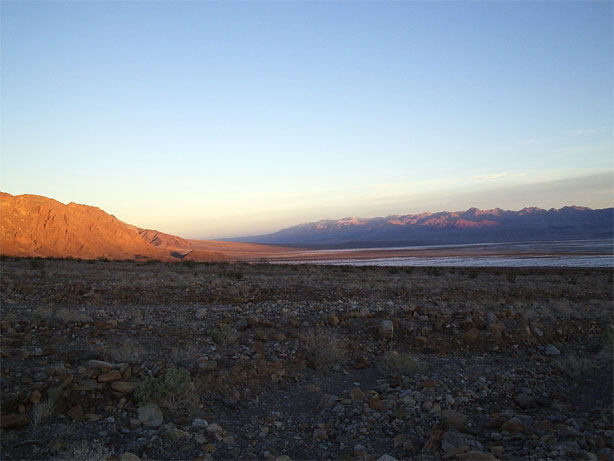
I dropped down through the wash to reach the powerlines, and found that the bare-track following them had improved to something approximating a road. Or, rather, something that didn't constantly hurt my feet with sharp rocks as I moved along it. I followed the powerlines as they ran around Tucki Wash, which I had confused with a spit of land, and then back along the side of the valley. Eventually I saw them beginning their run across the Badwater Valley toward Furnace Creek, which meant that the cush walking would soon come to an end.
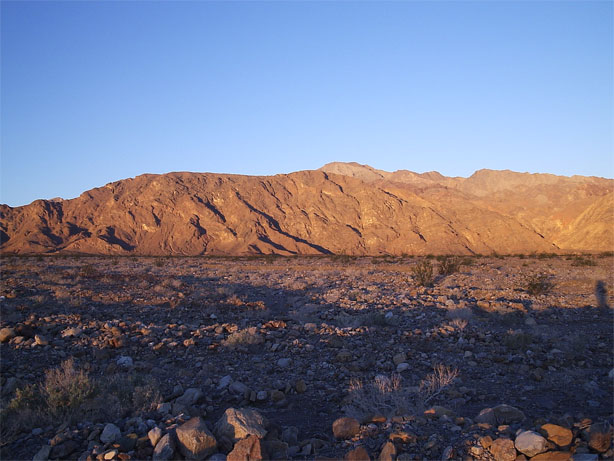
The foothills below Tucki mountain glowed bronze in the early morning sun and I again thought about how fortunate I was to be out here, and how smooth things were going. Except, of course, for my aching leg. It wasn't enough to really stop me, but it was getting to the point of agitating me. I had forgotten to take Ibuprofen before leaving the bench campsite this morning and was regretting it now. Without the pain reliever, walking was starting to get tiresome.
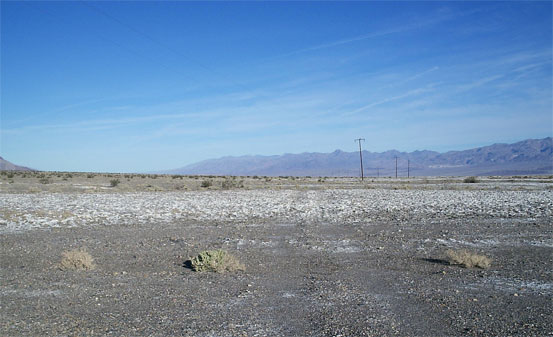
After a short break where the poles began their two or three mile trip across Badwater, I said goodbye to the pleasant "road" and set off down the valley, hoping that the salt flats would be in good condition and that the walking wouldn't be too hard. Initially things went well. The ground was firm and mostly sandy-gravel, with a light dusting of salt in a few patches. A large hump of salt appeared, heralding worse terrain to come, but set against the backdrop of the Panamints, with snowy Wildrose in the distance, this didn't seem too ominous to me at the time.
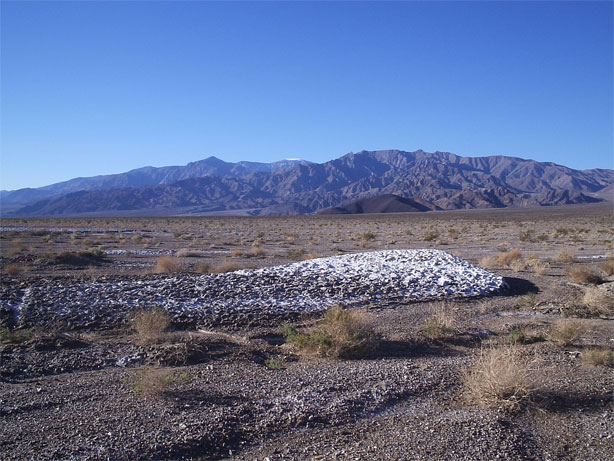
Spotting a large, white sea ahead of me, I turned toward the Panamints, hoping to run around it and save myself some effort, even if the route was longer. Unfortunately, the salt came fast and furious, and with it the salt coral that I had had difficulty with the day before in the salt cove. My ankles turned and twisted, which would have not been a problem, except that my right ankle is connected to my right knee. As the ankle torqued, the muscles behind the knee groaned toward something that was beginning to resemble actual pain. The sensible thing to do would have been to head straight to the Panamints and try my luck on the solid, if rocky, hillside. Instead, I found an interesting looking salt wash and followed it straight out into the valley. It was smooth, at least, and the day was still cool enough that hopefully the Devil's Golf Course might not be too hot. I tried not to think about what might happen if the salt flats were marshy, and headed out into the white sea.
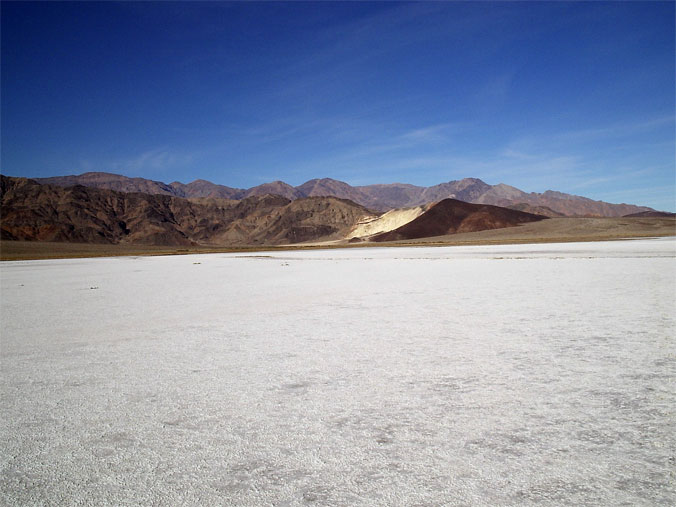
The Devil's Golf Course turned out to be, well, rather pleasant. While there were no clouds in the air, the wind picked up and I had an excellent tail wind pushing me down the valley. The salt was firm and the way clear and I was able to move much more comfortably than in the salt coral. Occasionally I would have to make a slight jog around a coral formation or two, but mostly I could move in a straightline.
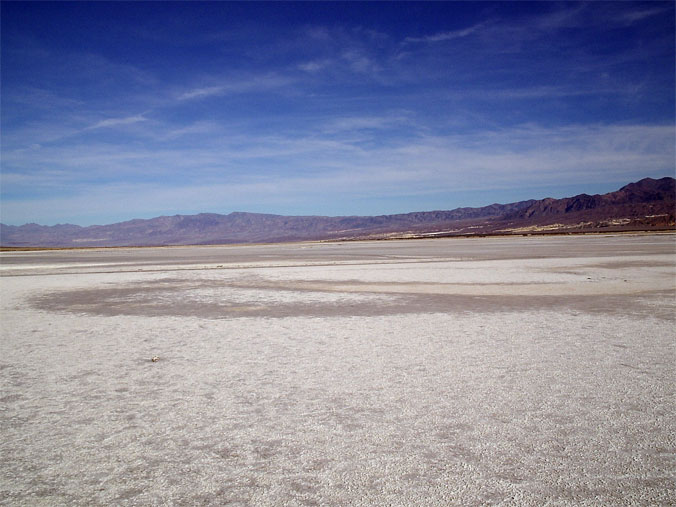
Looking up and down the valley floor, I was struck by the immensity of the open place that I was traversing, and this brought a certain joy to my heart which, coupled with the feeling of adventure gained by traversing a place where, in the right season, death would occur in less than an hour, drove me forward with a grin.
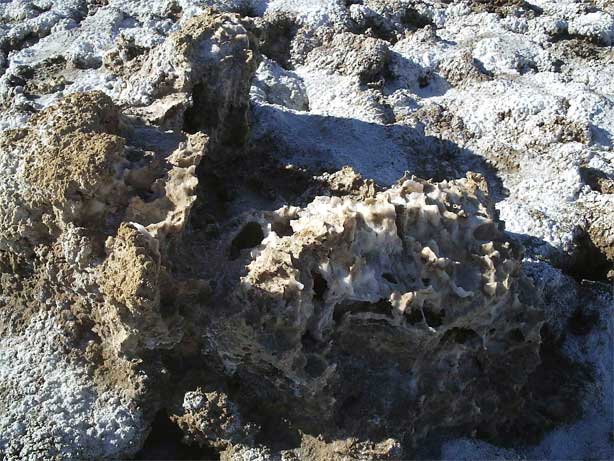
A large, dark mass on the valley floor drew closer and closer, forcing me to choose between running around it, or plowing through it. I was feeling so good that through it I went. Shorter, but no longer firm, the dark mass held little gems of salt carving, which were markedly different than the salt coral or sculptures that I had yet encountered. These intricately designed formations I decided to name salt abalone, not because they looked like abalone, but rather because they reminded me of some kind of wild superhotel for shellfish, and I happened to be thinking about a seafood dim sum place in the Vancouver that I like alot, and they happen to sell abalone. It was no more a fools name than any of the others I had heard of. The abalone were everywhere, some large and some small, in the dark land mass.

I finished my short cut through the land mass and got back onto solid salt once more. And then something shrieked at me. A crow flew by me, circled, and then landed about twenty feet from me, right in the middle of the Devil's Golf Course. I didn't even rate a vulture, but I was happy that I had a companion out here in the middle of nowhere. Perhaps the crow could see that I was starting to tire and was hoping for an easy meal after I expired (which, given the temperature and how much water I had on my back, would take about a week to occur). I shook my fist and my companion and moved off, determined to find a bush underwhich to rest for a while. I crossed another dark mass, this time muddying my shoes a bit, and watched solid ground slowly come my way. Not even pickle bushes grew out here, and I wanted some shade before I sat down for the noon meal-and-rest. Slowly, slowly came the land, and I started scoping out potential creosote bushes that might harbour quality shade. Long gone was the joy that I had initially felt. Now, all I could feel was my leg and how tired I was. Fifty feet, twenty, five, and I was on it once again. My crossing of the salt sea was done and I now only had to find a little shade.
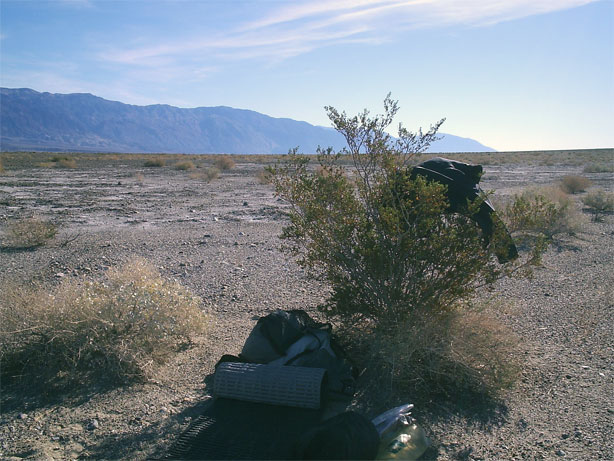
A large creosote sat only a few minutes walk away. There was nothing else in the world that I wanted at the moment, except its shade and some time to rest. This exemplifies the Why, typifies what I look for in living outofdoors. Shade, time, and some water were all that I wanted now, although the food in my pack and the wonderful Vitamin I were welcome. I had everything I needed on my back, and the shade of the creosote provided all the luxury that I could possibly want. I stayed under the bush for sometime, intermittently napping and shoveling a bit of food into my belly.
Well rested, and with the Ibuprofen working, I left the shade feeling much better and set out down the valley hoping to intersect Westside road sometime in the upcoming hour. The road is a gravel one and cars are welcome on it. It runs on the west side of the Badwater valley and it would be my superhighway for all of tomorrow, until I reached Warm Spring Canyon road and my food and water cache. Smooth walking all the way!
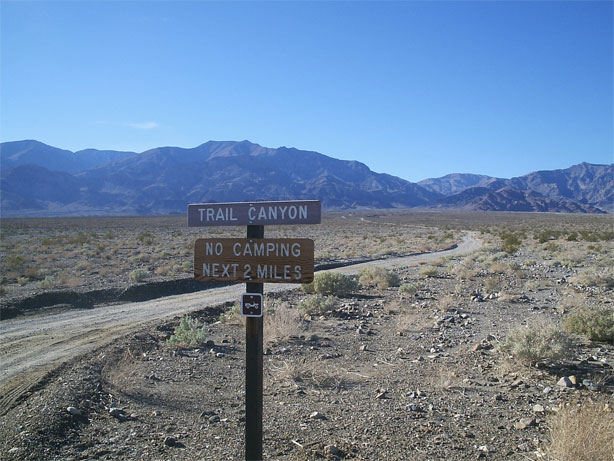
The road appeared and my adventure with the rocks ended. Unfortunately, as any hiker knows, walking on a road bed can be an exercise in pain management. Even though my leg was feeling better (Vitamin I), my feet were started to become rather abusive. Without water to rinse out my socks every day, the soles of my feet were starting to get irritated and I could feel a blister started to form on one of them. My left big toe started to hurt, as if it was getting a blister on it as well. This was rather puzzling to me as I hadn't blistered for several years. Novel, almost.

Shortly after crossing the junction with Trail Canyon, one of the prospective routes across the Panamints that I had looked into, I took another long rest break to get some relief from my feet and leg, hidden in the shade of a comfortable thicket and right next to a pickle bush. While I enjoyed the rest, my feet were now cold (in the sense of "cold muscles") and it took five minutes of limping before the blisters warmed up enough to allow me to walk in a semi-normal fashion. This wasn't good. Hopefully a fresh pair of socks would do the trick for tomorrow and there would be no more of this limping stuff.
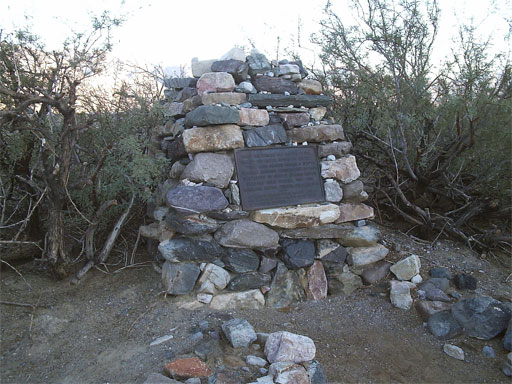
I passed a sign for Tule spring, and then shortly after a sign for "Shorty's Well", although I declined to visit either of them. I had no idea who Shorty was, nor did I need any more water, especially as any source in this area would be rather foul. A coyote sauntered across the road in front of me, not concerned with my presence in the least. Near where he had crossed I found a sign for Shorty's Grave, which brought forth some laughter into the afternoon desert air. I walked over to the grave, which the Park Service had marked with a plaque that had a few details about Shorty. Apparently he was something of a mining legend in the area and this was one of his favorite spots. He died sometime in the 1930s, which seemed a rather strange time to be looking for gold in Death Valley. His last request was to be buried here in the Valley, a place he loved dearly, and the government seems to have honored his wish.
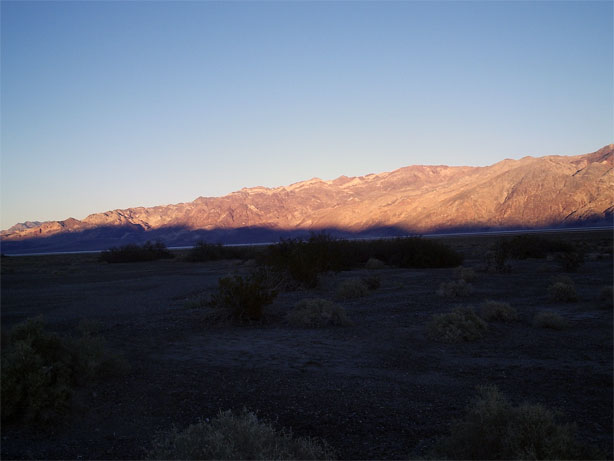
As the sun was almost behind the Panamints, I had to leave Shorty and find my own resting place for the night. It didn't seem right to camp at his grave, so I walked on for a while, passing an old borax site, until I decided that I was respectfully far enough from Shorty to camp. Technically I was breaking the park regulations by throwing out my sleeping bag only twenty feet from Westside Road next to some pleasant shrubs (camping is illegal within two miles of Westside Road), but I couldn't see the harm in it, especially as I had no car, was out of sight of the road, and wasn't even setting up a tent. No one would ever know that I had been here, no sign of my camp would be found after I had left in the morning, no harm done.
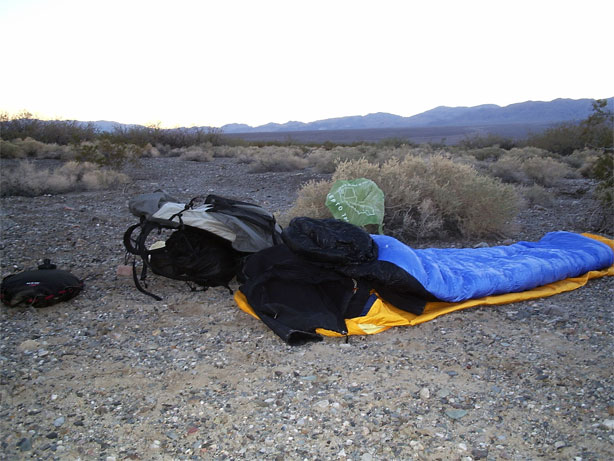
I fell quickly into the nightly ritual of food, tea, and Ibuprofen while watching the sun's final rays, for the day, illuminate the world around me, bouncing off the mountains and refracting colorfully in the clear desert air. A few clouds on the horizon gave the Artist something to work with and observing the progression of the light spectrum upon them made for a very effective timepiece, as well as for amusement. I was soon bathed in the darkness of the night, but neglected to turn on my headlamp for a while so that I could see the stars come out once again. The vastness of space and the huge immensity of our universe do not make me feel insignificant. Rather, they make me feel important, special. It is unclear in what degree the universe sustains intelligent life, although this is not a particularly important question to answer, or even contemplate. What is incontrovertible, and actually important, is that there is at least one sentient being, and he is watching an entire galaxy shine its million-year-old light once more. Watching from beneath a shrub, pondering the existence of others amongst all those dots of light above the desert floor. This is the Why.
Morning in the Valley, in the desert, is a sweet time and I can think of few finer morning rituals than drinking tea from a sleeping bag while watching the world come on fire for the day. Telescope Peak, the highest point in the valley, towered more than 11,000 feet above me. Except for Mount Rainier, Telescope has the largest differential between summit and base of any mountain in the States, although it is not what one would normally call a stunning mountain, particularly now as it held a light mantle of white snow on its crown.
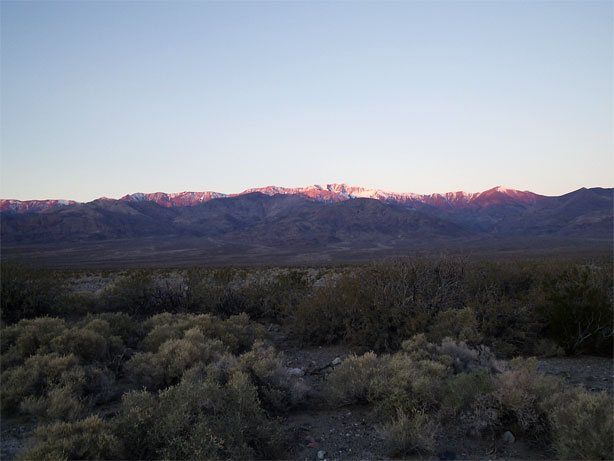
A mere 18 miles separated me from the food and water cache that I planted down near Warm Springs Canyon road. Eighteen miles and a decision. My leg was still bothering me, and now I had the added pain of two blisters. The one on the bottom of my foot would eventually pop and heal, but the one on my toe was a little more bothersome. It ran from the tip down and along the side of the nail, made a sharp turn and then ran along the base of the nail. It had the effect of lifting the nail up and twisting it a little. Not really painful, just bothersome. The leg was more of an issue. With a full load of Ibuprofen in me, I could walk more or less normally. However, after six hours, the Ibuprofen wore off and I would limp along, with little power to go up hill. To make matters worse, I was running out of Ibuprofen, although I had enough to make it through the Panamints.
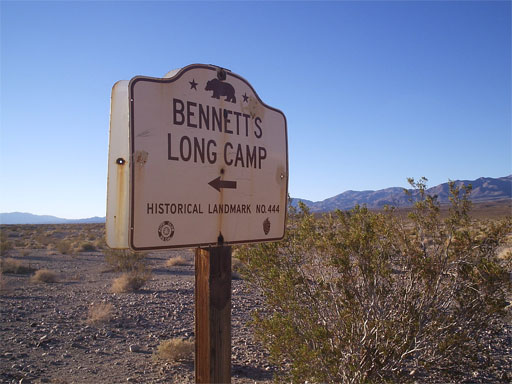
West Side Road was flat and easy to walk on, despite the blisters, and I was able to make good time down it, although it didn't hold any of the attractions of my off-road route for most of the trip. Most of the attractions that were there were of a historical nature, and set up for people in cars, which makes alot of sense given that they are accessed via a road. I tried not to think too much about my leg or the trip, but was entirely unsuccessful in this. With a hurt leg it made little sense to cross the Panamints via my planned cross country route in Anvil Spring Wash. I could take the longer, but safer Warm Springs Canyon road (a jeep track), but this wasn't particularly appealing to me at the moment.
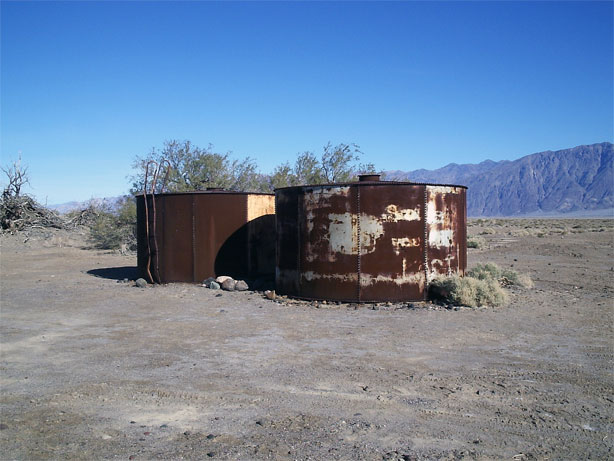
The day unfolded and I became grouchier and grouchier as it became clear that I was not going to continue on with my trip. From the cache, Badwater Road was only a mile and a half, and I would be able to hitch out without too much difficulty. Or, I could hike roughly seventy miles on a bad leg, half of it through the mountains, to get to Panamint Springs Resort. I had made the decision in my head a few hours ago, and my grouchiness was simply my heart trying to understand and accept the logical decision. My head battled against the vanities of my heart, trying to overcome the emotional roadblocks that the heart put in place with cold, mathematical precision. The mind would win eventually, but I was trying to speed up the procedure as much as possible.
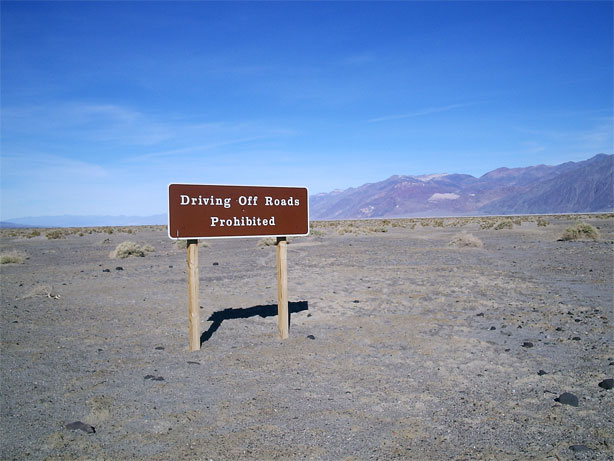
With about six miles to go to the cache, I heard a rumble from the north and turned to see a dust cloud coming down the road. A few minutes later, a green Jeep Cherokee pulled up along side me and the elderly couple inside asked if I needed a ride or water. They were the first people I had seen, let alone talked to, since I had left StovePipe wells a few days ago. I assured them that I was fine and thanked them for stopping, at which point they drove gently away, so as not to kick up too much dust. And then the decision seemed fine with the heart. All the anguish was gone and I started to again enjoy my time, now extremely limited, in the Valley.
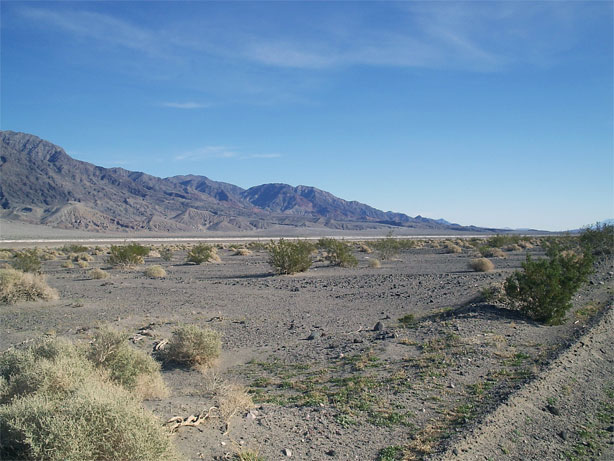
This wasn't how I imagined my trek ending, but it was good enough for now. I had traversed most of the length of the Valley floor, some 90 miles, while picking up water only once. I had seen some absolute treasures during my brief visit and experienced one of the most unique places on earth. The Valley was ending, here in the south, as the Panamints and Armagosa ranges began to converge, sealing off the valley with large, textured humps.
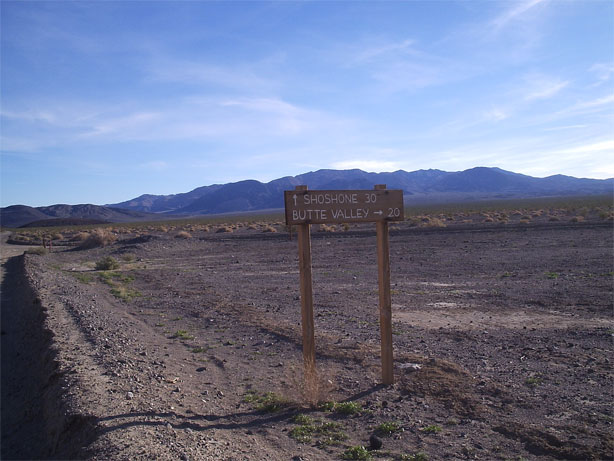
In the near distance I could make out a sign. It must be manmade, for in the desert it is impossible not to see those things that are not a part of it, that do not belong. A sign pointing to the west, where I should have been going, but could not, for now. The Butte Valley looked so interesting on the maps that I had and Anvil Spring Wash seemed to be the best way, for those on foot, to reach it. No amount of longing could make my leg better and heading into the hills on a bad leg, alone, did not seem like the wisest of decisions. Taking the road, which might be traveled by off road vehicles, was still not very appealing to me. No, I was done.

I crossed Warm Springs Canyon road and found the food and water cache in tact, split between the two different hiding places that I had found for it. I had a bucket of food and 5 gallons of water here, and it wasn't even three o'clock yet. I found a sufficiently large creosote bush and moved all my stuff over to its plentiful shade. My room for the night. I was camping illegally once again, and was well within view of both Warm Springs Canyon Road and West Side Road, but didn't care very much. I wasn't doing anything any harm and if a ranger wanted to drive down here and evict me, so be it.

I made some tea and starting eating as much of the food as I could, so as not to have to haul it around with me while hitching back to my car, 80 GPS miles to the north. It was quiet here and the breeze was blowing, and I didn't think for a moment about hitching out today. I wanted another night in the desert, another sunshow, more stars, more of everything. To the north stretched the land that I had traversed so recently. Death Valley. A magical place haunted by disturbed miners and the occasional hiker, but mostly left alone now that the mountain sides are protected within a national park.
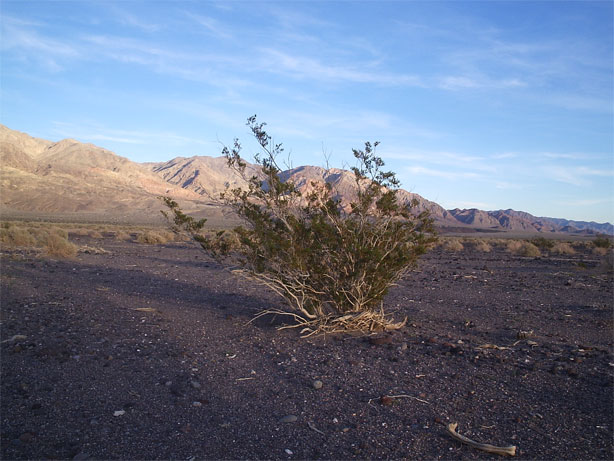
With my shoes off, I limped around a little bit near my home for the night, picking at rocks and taking numerous pictures of a single creosote as the light changed with the sun's sliding to the mountains. What was once tan turned to gold. Beige turned to bronze. Brown turned to chocolate. Shadows lengthened and the best time of the day was upon the Valley. Soon the sky would light up and the mountains would shed their conservative colors for gaudy reds and purples. There were enough clouds in the sky for a better than average show this evening. Providence was smiling upon me for this my last night in town.

While awaiting my private showing, I examined my feet, finding more to laugh at than lament. The toe nail blister was looking rather unhappy and I was sure that I was going to lose the toe nail at some point in the near future. It was puffy and the nail was now so twisted and lifted that I thought it would make for a nice display in a medical book.
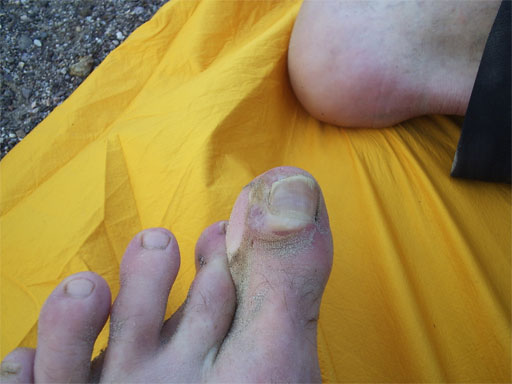
The blister on the bottom of my foot was truly enormous. Most likely caused by all the sand that my socks had absorbed (I haven't blistered for some time now), it was ponderous and irritated and the swollen skin held back a pond of liquid that I sent rushing back and forth with a turn of my ankle.
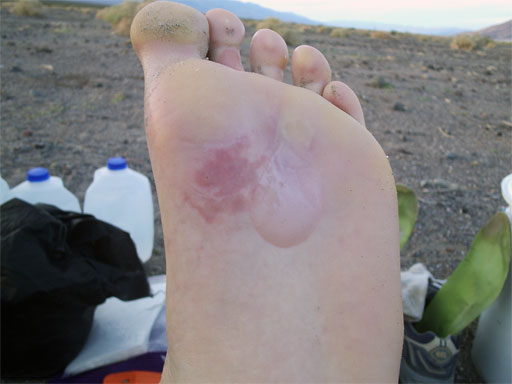
I put my feet away and turned to more food. Fudge, salami, cheese, crackers, and lots of water. The sun sank low and the show began. Nature's little display of vanity, of posing and primping and showing off was everywhere tonight. No camera can render such a time with any accuracy, at least partially because time is involved. It isn't just the display that is so nice. Rather, it is the progression of color and light through time that holds interest.
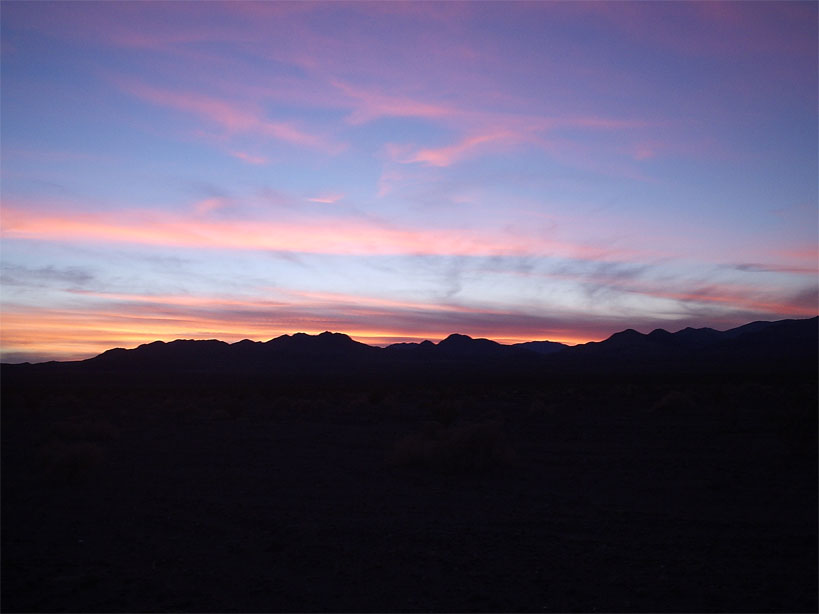
Static things like cameras cannot capture this aspect with any adequacy, even if they were sophisticated enough to capture the subtle variations on color and tone that are produced at sundown in places like this. No, to experience such a place you need to actually go to it, not just look at it through someone else's lens.
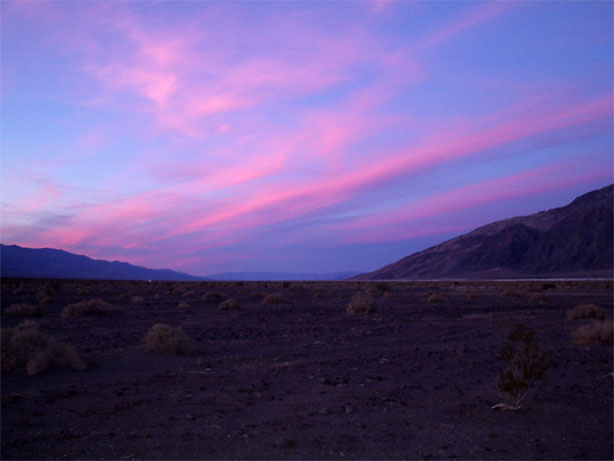
The light show ended for the day and I fired up my stove for some more tea before the stars fully came out. I had eaten so much fudge that going to sleep would be difficult anyways, so there was no reason not to have more hot tea with my evening companions. Throughout the night I would occasionally turn on my headlamp and read ten or twenty pages of Dostoevsky, before extinguishing it and seeing what the stars had been up to in the intervening thirty or forty minutes when I had shut them out. Although I liked the novel I was reading (The Idiot), the night sky would always win out in a place like this. I swatted a few mosquitoes, whose existence, in this place, was still a source of amusement and frustration. Sleep would not come easily on this last night, which was fine with me. I was content, even if disappointed, in the ending of my trek so early and after far too little space and experience. But I was done, and knew it. And so, the stars knew it as well.
Transit day. Moving day. Nothing of importance, just going from one place to another. After tea and the morning show, I packed up my stuff, watered a few of the bushes with my wonderful cache water, and headed across the salt flats over to Badwater road. The flats were broken up in the middle by the mighty Armagosa river, which was quite dry, but apparently funnels, or used to funnel, a large amount of water given the right conditions.

I sat on my bucket in the shade by the side of the road and waited for a car to come by, contenting myself by reading about the troubles of Prince Myshkin and Dostoevsky's thoughts on capital punishment and socialism. Four cars passed in the first hour, none of them even giving me a look. However, thirty minutes later a Toyota pickup slowed down and then stopped. "Where you going, Elvis?" asked the man in the driver's side. I related my story and he told me to hop in the bed (he was traveling with a friend). And off we sped up Badwater road. The best hitch possible is in the back of a pickup and I was happy that Brett had stopped to give me a lift. We stopped at the official Badwater front country sight for pictures and to chat a little bit. Brett was an artist living near Temecula, which is in the desert between San Diego and the LA megaplex. He showed me a rather clever poster he had drawn depicting several famous artists. Vlad, his passenger and friend, was a sculptor and had a postcard with one of his larger works, which sat in front of a local metropolitan building in San Diego. After looking around Badwater, we sped toward Furnace Creek, where they were turning off, hopefully to go to Dante's View. I thanked them again and walked down the road to Furnace Creek, where I hoped to score another easy hitch back to my car.
About a minute of standing across from the visitor's center at Furnace Creek was all it took to get a ride. A Subaru Outback turned around and came by to pick me up. The pretty woman driving it agreed to take me up to Mesquite, although she had originally intended to spend the day in the southern end of the park. She wanted to see Scotty's Castle anyways, and changed her plans on the spot. People like her and Brett made long distance hiking much easier, and I wondered if they had any idea how helpful they were being. We chatted for the entire 55 miles up to Mesquite, where she dropped me off, right next to my car. And then I was alone once again, my trip completely over.

I pulled a semi-cool Budweiser from my trunk along with a doughnut and had a impromptu brunch in the parking area. As filthy as I was, I declined to put on clean clothes, deciding to stay dirty until I could get completely clean this evening in Ridgecrest. I finished the beer, packed the trunk, and sped off down the road, heading for Panamint Springs and my food box. The miles flashed by in the car, the time spent searching for a radio station. I tried to ignore my disappointment in how my winter trek had turned out. Tried to focus on the positives, but could not shake the feeling that I had unfinished business in Death Valley. That I would have to be back sometime, someday. Someday. That is how things always stand at the end of a trip in the wilderness. It is the Why.




























































